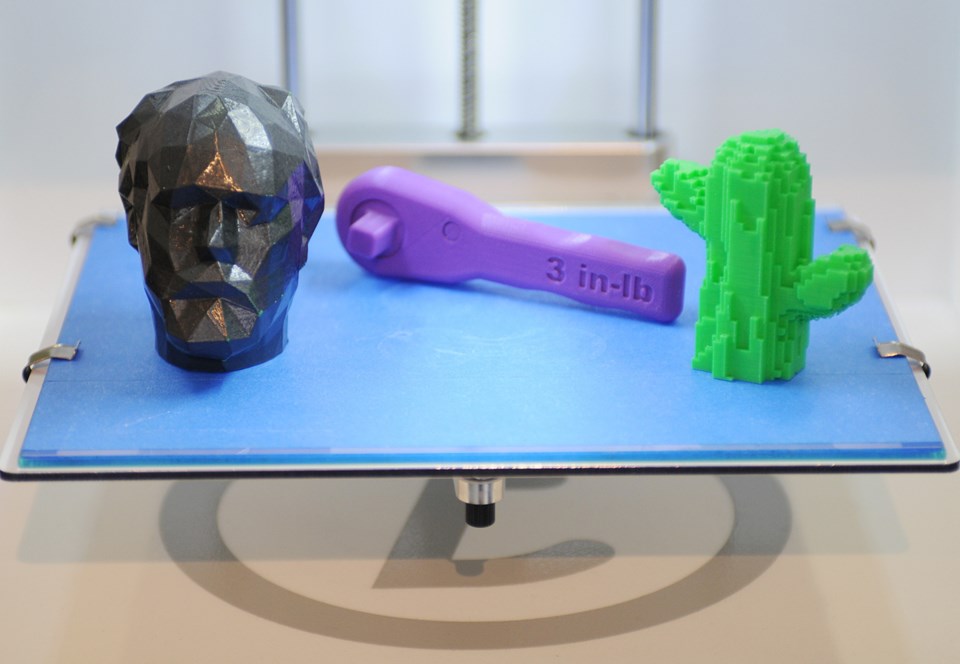Replacement body parts 3D-printed with live cells are one of the possibilities that excites John Biehler most.
“I have a clip of a human heart valve that’s being 3D-printed,” said Biehler, a technologist, consultant and blogger.
It’s one of the many videos he’ll share at the Vancouver Mini Maker Faire, June 6 and 7 at the PNE Forum.
“With 3D printing they can actually grow the cells from your own body so that your body won’t reject it,” Biehler noted, adding researchers aren’t yet at the implant stage.
The other prospect that fires his imagination is 3D printing in space.
Biehler says both NASA and the European Space Agency want to create a colony on the Moon. He has a video that reveals the European Space Agency proposes using a tent that’s shored up with a “concrete” wall printed from available water and moon dust.
“It’s a pretty compelling video,” he said. “They figured out a lot of the hard stuff already.”
Biehler, also an instructor, traveller and photographer, first used 3D printing to create custom camera mounts. Now he’s been named as a top 3D printing innovator and influencer by multiple organizations because he’s so swift and prolific when it comes to sharing new developments.
Biehler will describe and demystify the current state of 3D printing in a talk on Saturday using photos, videos and physical samples. He’ll moderate a panel about establishing a maker space on Sunday, and he’s wrangled owners of homemade to high-end 3D printers to populate a 3D Printing Village at the event so visitors can see printers in action.
“We really want to show people what’s possible with it and get people excited about this technology,” Biehler said.

He’ll show onlookers 3D printers can fashion forms out of more than plastic.
Biehler has printed the tree character Groot from the Guardians of the Galaxy movie with bamboo filament, and items that have been printed with metal will also be on hand.
Unfortunately, the machine that prints designs with pancake batter onto a griddle that he ordered for $150 won’t get to him in time for Mini Maker Faire.
Biehler says GE and Airbus recently printed a jet engine out of metal. In their quest to cut fuels costs, he said major airplane manufacturers are using thousands of 3D printed parts, such as components that hold wires in place, to make their planes stronger and lighter.
He notes printing objects with 3D printers is an additive, not a subtractive process. Instead of a form being carved from a material (subtractive), only that form is fashioned from the raw material. “It’s a very good manufacturing method that doesn’t have a lot of waste, because we only use what you need,” Biehler said.
One of the most heartwarming stories he tells is tells is about Enabling the Future initiative.
The project started with a carpenter in South Africa who saw online a hand a Seattle man had fashioned for a cosplay costume and asked if there was a way they could collaborate to make him a replacement for the fingers he had lost.
Fast-forward a couple of years and now Enabling the Future matches volunteers with 3D printers with people, mostly children, in need of prosthetic hands.
Biehler said some of these kids were shunned on the playground until they received a superhero-themed hand.
“And now they’ve become like a superhero on the playground and so their self-esteem and their confidence has gone way up, and if they break a finger or they grow, it’s easy enough to reprint and upgrade that at a very minimal cost, if not basically free,” he said. “They’re blowing away people that were in prosthetics because… a typical prosthetic hand with very limited functionality would start at $10,000.”
Vancouver Mini Maker Faire includes two full days of talks and showcases makers’ technological, craft and other inventive creations. More than 70 of the exhibits include a free or low-cost hands-on activity, from learning to solder with the Vancouver Hack Space, programming a robot with Brickbots or learning to weave with The Craft Lab.
“The main thing of Maker Faire is it’s not just for geeks,” Biehler said. “There’s lots out there for everybody and we try to make it as accessible as possible and, basically, just bring your questions and an open mind and come see some really cool stuff.”
For more information, see makerfaire.ca.
crossi@vancourier.com
@Cheryl_Rossi


